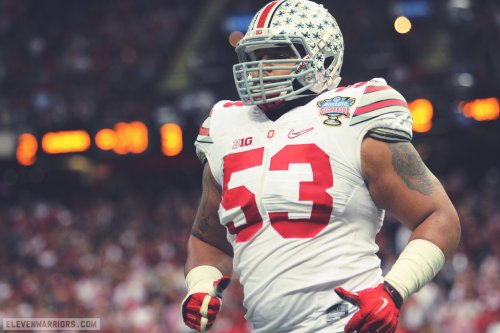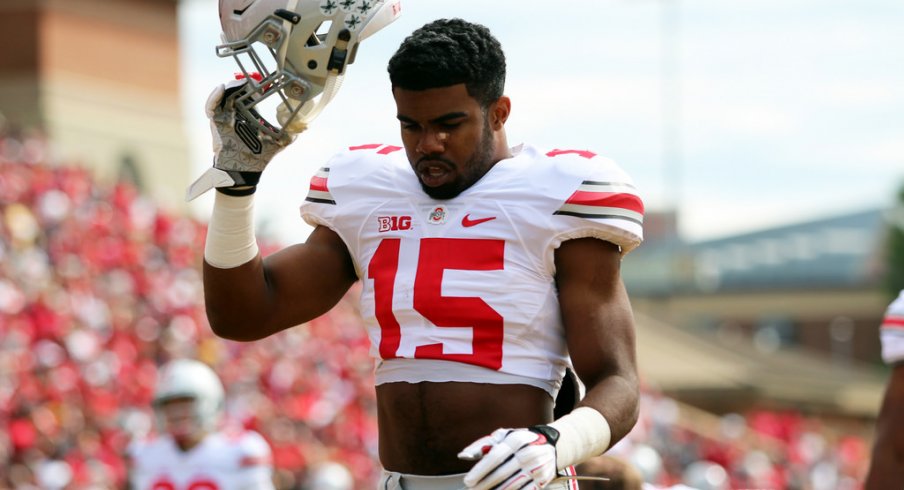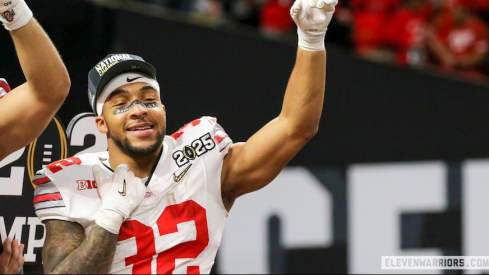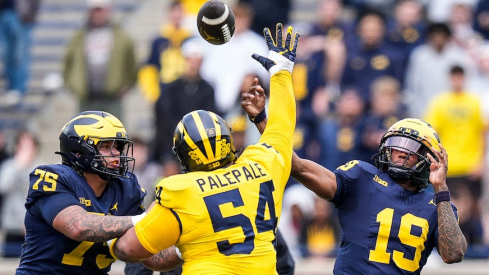During Ohio State's national championship run, no Buckeye was more visually striking than Ezekiel Elliott. The reason was clear: Elliott's crop top.
Frequently in 2014, Elliott would roll up the lower half of his jersey into his shoulder pads, creating a half-jersey and a good view of his abdominal muscles. Elliott said he wore it that way because he disliked how loose jerseys were at the bottom. And if tucking the jersey made an already elusive running back even more slippery... why would Ohio State object?
The crop top jersey was popular with fans, but its time is over. In March, the NCAA Football Rules Committee approved a measure that would essentially kill off Elliott's crop top:
Officials will treat illegal equipment issues – such as jerseys tucked under the shoulder pads or exposed back pads – by making the player leave the field for at least one play. The equipment must be corrected for the player to return to the game. The player may remain in the game if his team takes a timeout to correct the equipment issue.
With the word that Ezekiel Elliott may no longer wear a belly shirt on the football field, I'd like to take a look at some of the other Buckeyes whose fashion trends have been cut short by the NCAA.
Joey Galloway
Joey Galloway is well known as an NFL wide receiver and a college football analyst (in fact, one who just got a significant boost in stature). In his college career, as a Buckeye, Galloway dazzled crowds with high-flying catches. Here's an example, a 25-yard touchdown reception from the 1993 Penn State game:
You may notice something unusual about the touchdown celebration. After the score, Galloway removed his helmet and to greet teammates, and then nodded at the camera. These days, that's a no-no.
Some time after the mid-1990s, the NCAA passed Rule 9-2-1-f, forbidding a player from "removing his helmet after the ball is dead and before he is in the team area", turning it into an unsportsmanlike conduct penalty. Galloway's act would nowadays cost his team 15 yards.
Terrelle Pryor
Although he was by no means the first player to express himself on the football field, Terrelle Pryor may be known as one of the most controversial.
On Sept. 5, 2009, for Ohio State's season opener against Navy, Pryor wrote "MIKA" and "VICK" in silver lettering on his eye black. Pryor said "MIKA" was a reference to his sister and "VICK" was a statement of support for Michael Vick, who had been released from prison after serving a sentence for animal cruelty charges. Pryor's defense of Vick was very poorly received, and soon after Pryor apologized for the message.
The following year, the Football Rules Committee passed Rule 1-4-6-e, mandating that eye black under a player's eyes "must be solid black with no words, numbers, logos or other symbols." Pryor wasn't the primary reason for the ban – Tim Tebow's Bible verses were – but his was one of the most infamous messages.
Devier Posey and Mike Adams
Unlike some of the other people on this list, the fashion statement DeVier Posey and Mike Adams made wasn't banned by the NCAA. Instead, they were hurt by being some of the first to take advantage of a legal uniform choice.

Starting in 2010, Nike started to make custom gloves for teams in its Pro Combat series, gloves that would display a school logo when pressed together. It was a Block O for Ohio State, but Posey would find out the hard way that referees do not take kindly to corporate synergy.
In the second quarter of the Michigan game, Posey took a short pass from Pryor for a 33-yard score, after which he made a Block O for the adoring Columbus crowd. Big mistake: the referees penalized OSU 15 yards for taunting. Adams would be flagged for the same gesture later in the game, again for "taunting" a home crowd.
It didn't affect the Buckeyes that day, as they beat Michigan handily, but the flags would lead to more sensible enforcement of taunting and excessive celebration penalties down the road.
Michael Bennett
Ezekiel Elliott wasn't the only Buckeye on the 2014 championship team to have a style under fire. Michael Bennett also enjoyed something that will be taken away next year: the overbuilt face mask.
Defensive line is a physically demanding place to play, even more so with all the dirty tricks offensive linemen pull like grabbing face masks or eye gouging. One way linemen have addressed this is by wearing an overbuilt face mask, which has an excessive number of horizontal and vertical bars to make the face mask harder to grab.
Bennett started to wear a gridlike pattern as a junior, and as a senior he wore a full grid with an eye shield for maximum protection. Unfortunately for him, it may have been counterproductive: when an Oregon offensive lineman eye gouged him under the mask, the referees didn't see it and he drew a personal foul for retaliation.
Bennett's use of an overbuilt mask came just in time. The Rules Committee voted to take it out of college football in 2015, following the NFL's lead. It may be ineffective at protecting one's face, and it may cause dangerous neck fatigue as the NFL claims. One thing is for sure: it looks menacing.
Elliott, Galloway, Pryor, Posey, Adams and Bennett are only the most notable Buckeyes to fall victim to illegal equipment enforcement. Future Buckeyes will no doubt be at odds with uniform regulations; when that happens, one can only hope they find novel ways to violate the dress code.


